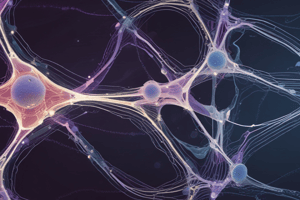Podcast
Questions and Answers
What is the driving force behind molecular recognition?
What is the driving force behind molecular recognition?
Thermodynamics (Gibbs free energy differences)
Name one example of molecular recognition in biological systems.
Name one example of molecular recognition in biological systems.
Neurotransmitter/receptor or enzyme/substrate
Who proposed the Lock-and-key principle for molecular recognition?
Who proposed the Lock-and-key principle for molecular recognition?
Emil Fischer
Which proposal for molecular recognition is generally accepted today?
Which proposal for molecular recognition is generally accepted today?
What are some factors that contribute to the overall Gibbs free energy changes in receptor-ligand interactions?
What are some factors that contribute to the overall Gibbs free energy changes in receptor-ligand interactions?
What is the hydrophobic effect?
What is the hydrophobic effect?
How is the energy contribution of the hydrophobic effect typically measured?
How is the energy contribution of the hydrophobic effect typically measured?
What happens to water molecules around non-polar groups when they approach each other?
What happens to water molecules around non-polar groups when they approach each other?
What factor is the magnitude of the hydrophobic effect related to?
What factor is the magnitude of the hydrophobic effect related to?
What is the main driving force behind the hydrophobic effect?
What is the main driving force behind the hydrophobic effect?
What type of interactions contribute to the energy in the binding cavity?
What type of interactions contribute to the energy in the binding cavity?
How are H-bonds defined in terms of atoms involved and their distance?
How are H-bonds defined in terms of atoms involved and their distance?
What is the optimal angle for H-bonds?
What is the optimal angle for H-bonds?
Which type of interaction can lead to a 50-500-fold increase in affinity?
Which type of interaction can lead to a 50-500-fold increase in affinity?
What are the two types of interactions involving aromatic ring systems?
What are the two types of interactions involving aromatic ring systems?
Which amino acids are involved in cation-pi interactions?
Which amino acids are involved in cation-pi interactions?
What type of interactions does ligand/drug design mainly focus on, especially H-bonding?
What type of interactions does ligand/drug design mainly focus on, especially H-bonding?
How does the elimination of the glycerol moiety by hydrophobic alkyl groups affect the interaction with the enzyme?
How does the elimination of the glycerol moiety by hydrophobic alkyl groups affect the interaction with the enzyme?
What type of interactions are electrostatic in nature?
What type of interactions are electrostatic in nature?
What is the weak attractive force at intermediate distances due to in vdW interactions?
What is the weak attractive force at intermediate distances due to in vdW interactions?
How can hydrophobic and vdW interactions be used when crystal structures are not available?
How can hydrophobic and vdW interactions be used when crystal structures are not available?
What can be estimated by exploring the binding of methyl-substituted flavones to a receptor?
What can be estimated by exploring the binding of methyl-substituted flavones to a receptor?
What is the equilibrium constant used for in medicinal chemistry?
What is the equilibrium constant used for in medicinal chemistry?
How is the inhibition constant (KI) often used in Medicinal Chemistry?
How is the inhibition constant (KI) often used in Medicinal Chemistry?
What does the IC50 value represent in a radioligand displacement assay?
What does the IC50 value represent in a radioligand displacement assay?
How can the KI value be determined from the IC50 value?
How can the KI value be determined from the IC50 value?
What does a higher affinity (more negative ∆G) correspond to in terms of the inhibition constant KI?
What does a higher affinity (more negative ∆G) correspond to in terms of the inhibition constant KI?
What is the consequence of a 10-fold loss in affinity in terms of the change in ∆G?
What is the consequence of a 10-fold loss in affinity in terms of the change in ∆G?
What contributes to the increase in ∆G during receptor-ligand binding?
What contributes to the increase in ∆G during receptor-ligand binding?
What is one way to reduce the energy penalty resulting from internal motion during binding?
What is one way to reduce the energy penalty resulting from internal motion during binding?
What is the penalty associated with induced conformational changes during binding of palmitic acid to adipocyte lipid-binding protein?
What is the penalty associated with induced conformational changes during binding of palmitic acid to adipocyte lipid-binding protein?
Why must the energy penalty from conformational changes during binding be compensated for?
Why must the energy penalty from conformational changes during binding be compensated for?
Study Notes
Hydrophobic Effect
- The hydrophobic effect is the propensity of non-polar compounds to transfer to an organic phase or to interact with each other.
- This interaction is not due to an attractive force between non-polar compounds, but rather due to an entropically favoured rearrangement of water/solvent molecules.
- Energy contribution: 0.1 – 0.24 kJ/mol Ų.
- When two non-polar groups approach each other, the water molecules around one group become disordered to associate with the water molecules of the other group.
- The magnitude of the hydrophobic effect is related to the surface area of the non-polar groups, leading to increases in entropy and therefore decreases in ∆G.
Ligand/Drug Design
- Ligand/drug design mainly focuses on electrostatic interactions (especially H-bonding) because of the larger contributions to ∆G.
- However, strong H-bonds can sometimes be replaced by hydrophobic interactions.
- Example: Compound 2.1, a fairly potent inhibitor of influenza neuraminidase, interacts favourably with the enzyme via strong H-bonds, which can be replaced by hydrophobic interactions.
van der Waals (vdW) Interactions
- vdW interactions are electrostatic in nature.
- The weak (0.2 kJ/mol) attractive force at intermediate distances (about 3 Å) is due to dispersion forces (temporary/induced dipoles).
- Hydrophobic and vdW interactions can be used to map out a receptor cavity or an enzyme active site (if there are no crystal structures available).
Mapping Receptor-Ligand Binding Sites
- Example: Using CH₃ groups to scan or map a receptor-ligand binding site, such as the binding of a variety of methyl-substituted flavones to the GABAA receptor.
- Through the measurement of inhibition constants, it is possible to estimate the dimensions of the binding site.
Principles of Molecular Recognition
- The function of every biological system is based on molecular recognition (e.g., neurotransmitter/receptor, enzyme/substrate).
- Molecular recognition is driven by thermodynamics (Gibbs free energy differences).
- In biochemistry, there are two prominent proposals for molecular recognition: Emil Fischer’s Lock-and-key principle and Daniel Koshland’s Induced-fit hypothesis.
Receptor-Ligand Interactions
- The interaction between receptor and ligand may involve conformational changes in the ligand, receptor, or both (induced-fit model), desolvation, and solvent reorganization.
- All these contribute to the overall Gibbs free energy changes.
Electrostatic Interactions
- Electrostatic interactions are due to the interactions between polar groups in the ligand and protein (side chains, back-bone amides).
- Electrostatic interactions are often divided into:
- Ion-ion interactions (salt bridges) – not orientation-dependent.
- Ion-dipole interactions – orientation-dependent.
- Dipole-dipole interaction – orientation-dependent.
Hydrogen Bonding
- H-bonds can be regarded as a dipole-dipole interaction between a hydrogen atom bound to an electronegative atom and an additional electronegative H-bond acceptor atom.
- Typical H-bond distance between the donor and acceptor atoms: 2.5-3.0 Å.
- H-bonds are orientation-dependent (optimal angle is 180 deg).
- Energy contribution per H-bond in a binding cavity: 2-6.5 kJ/mol.
Aromatic Ring Systems
- π-π (π-stacking) and cation-π interactions are electrostatic interactions.
- Such interactions can occur with protein side chains (Phe, Tyr, Trp as aromatics or Lys, Arg as cations).
- Cation-π interactions can be quite strong (8-17 kJ/mol).
Inhibition Constants
- The inhibition constant (KI) is often used in Medicinal Chemistry to express the affinity of a ligand for a molecular target (enzyme, receptor, …).
- Alternatively, IC50 values are frequently used to express affinities.
- The IC50 denotes the concentration of an inhibitor that causes the dissociation of 50% of a receptor-bound radioactively labeled ligand in a radioligand displacement assay.
Binding Affinities
- A higher affinity (more negative ∆G) corresponds to a smaller value of KI (nM, μM).
- Based on ∆G = RT ln K: a 10-fold loss in affinity corresponds to an increase in ∆G by 5.6 kJ/mol at room temperature (293 K).
- Slight structural changes can significantly alter binding affinities (needs to be taken into account when designing new ligands or drug candidates).
Forces Driving Molecular Recognition
- The forces that drive molecular recognition and their contribution to ∆G include:
- Hydrophobic effect
- vdW interactions
- Electrostatic interactions
- H-bonds
- Aromatic ring systems
- Conformational changes (entropy penalty)
- Internal motion (entropy penalty)
- These forces should be taken into account during ligand/drug design.
Studying That Suits You
Use AI to generate personalized quizzes and flashcards to suit your learning preferences.
Related Documents
Description
Test your understanding of principles of molecular recognition in biochemistry, including concepts like the lock-and-key principle and induced-fit hypothesis. Explore how biological systems function based on molecular interactions and thermodynamics.




